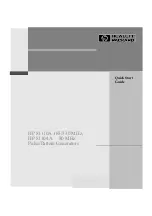
100165 - 7500W DUAL FUEL ELECTRIC START GENERATOR
OPERATION
20
Electric Start
1. Move the choke to 75% of the “CHOKE” position.
1a. For restarting a warm engine, move the choke the same
position.
2. Press the battery switch to the “ON” position.
3. Press and hold the ignition switch to the “START” position.
Release as the engine begins to start. If the engine fails to
start within five seconds, release the switch and wait at least
ten seconds before attempting to start the engine again.
4. Do not over-choke. As soon as engine starts, move the choke
to the “RUN” position over a 2-5 second duration.
CAUTION
If the ignition switch is held down in the “START” position
longer than 5 seconds it could damage the starter.
Manual Start
1. Press the ignition switch to the “ON” position.
2. Move the choke to the “CHOKE” position.
2a. For restarting a warm engine, move the choke the same
position.
3. PULL-TO-PRIME: Pull the recoil cord slowly until resistance is
felt and then pull rapidly. Pull with 100% “CHOKE” 2-3 times
until you feel a few combustion pulses that indicates that the
engine momentarily started.
4. Move the choke to the “RUN” position.
5. Pull the recoil cord slowly until resistance is felt and then pull
rapidly.
6. If engine fails to start in 1-pull with choke in the “RUN”, then
move choke to the “CHOKE” position and repeat the PULL-
TO-PRIME step.
7. Do not over-choke. As soon as engine starts, move the choke
to the “RUN” position over a 2-5 second duration.
NOTICE
For LPG starting in cold ambient < 59°F (15°C),
move the
choke lever to “CHOKE” for manual start. To PULL-TO-PRIME
for manual start, pull with choke in the “CHOKE” position 2-3
times until you feel a few combustion pulses that indicates that
the engine momentarily started.
NOTICE
If the engine starts but does not run make certain that the
generator is on a flat, level surface. The engine is equipped
with a low oil sensor that will prevent the engine from running
when the oil level falls below a critical threshold.
NOTICE
Accumulation of frost on LPG cylinder and regulators is
common during operation and normally is not an indication
of a problem. As LPG vaporizes and travels from the cylinder
to the generator engine it expands. The amount of frost that
forms can be affected by the size of the cylinder, the amount
of LPG being used, the humidity of the air and other operating
conditions.
In unusual situations this frost may eventually restrict the flow
of LPG to the generator resulting in deteriorating performance.
For example, if the cylinder temperature is reduced to a very
low level then the rate at which the LPG vaporizes is also
reduced and may not provide sufficient flow to the engine. This
is not an indication of a problem with the generator but only
a problem with the flow of LPG from the cylinder. If generator
performance seems to be deteriorating at the same time that
ice formation is observed on tank valve, hose or regulator then
some actions may be taken to eliminate this symptom.
In these rare situations it can be helpful to reduce or eliminate
the cold fuel system effects by doing one of the following:
–
Exchanging fuel cylinders to allow the first cylinder to
warm up, repeating as necessary.
–
Placing the cylinder at the end of the generator near the
handle, where engine fan air flows out from the generator.
This air is slightly heated by flowing over the engine. The
cylinder should not be placed in the path of the muffler
outlet.
–
The cylinder can be temporarily warmed by pouring warm
water over the top of the cylinder.
battery
NOTICE
When the battery switch is in the “ON” position, the switch
will light up if the battery is sending out a charge. If the switch
does not light up while in the “ON” position, check that the
battery connection is still good.
NOTICE
The supplied 12V battery does re-charge while the engine
is running and the battery switch is turned ON, but it is also
recommended that the battery be fully charged at least once
per month or maintained with a trickle charger or battery
maintainer (not included).














































